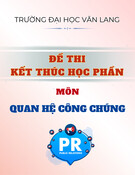2/e
P
P T
©2007 by the McGrawHill Companies, Inc. All rights reserved.
8
Business Writing Design
©2007 by the McGrawHill Companies, Inc. All rights reserved.
McGrawHill/Irwin
Thinking through the Written Design
Warren Buffet uses a clear and down- to-earth writing style that really engages readers of his Berkshire Hathaway’s annual report.
© Eric Francis/Getty Images
3
The Writing Process
Freewriting
◦
process of writing all the message ideas that come into your mind nonstop without lifting your pen or pausing at the computer
Listing
◦
composing a list of all the things that need to go into the document you plan to write
Clustering
◦
determining the relationships among the ideas of a message
4
1. Generating ideas and prewriting
The Writing Process
FIGURE 8.1 Clustering
5
The Writing Process
• Gathering information
• Considering strategy
Direct strategy
◦
states the message goal first
Indirect strategy
◦ warms up the audience with information and goodwill
before delivering the message goal
6
2. Writing
The Writing Process
• Outlining and drafting
Outline
◦
structured list of the information to be included in the message
Drafting
◦ writing the first version of text on paper or computer
screen
Accumulative
Relational
7
2. Writing (continued)
The Writing Process
• Revising
◦
re-vision, looking at the document as if you had never seen it before • Re-outlining
◦ writing a new outline based on the original document you
wrote • Slash and burn
◦
total revision strategy in which you select certain points of a document and then rewrite it using only those points from the original work
3. Revising and redrafting
8
4. Editing and proofreading
The Writing Process
FIGURE 8.2 Slash and Burn
9
Business Writing Style
Business writing focuses on the audience and how they will interpret and respond to the message. © Ryan McVay/Getty Images
10
Business Writing Style
“You” view
◦ writing that is focused on the interests of
readers
• The “You” View
• How Do I Know My Message Has the
“You” View?
• The “You” View Builds Good Public
11
Relations
Business Writing Style
• Should I Always Use the “You” View?
12
• Positive Expression and Reader Benefits
Business Writing Style
13
• Active Sentences and Concrete Language
Business Writing Style
(continued)
14
• Active Sentences and Concrete Language
Business Writing Style
(continued)
• Active Sentences and Concrete Language
15
• Grammatical Correctness
Designing Memos and Letters
FIGURE 8.3 Components of Letters and Memos
16
Designing Memos and Letters
• Introduction
• Body
• Closing
17
• Formatting Margins Font Justification
Designing Memos and Letters
internal, written channel of communication
Marion King, CEO, Industrial Enterprises Justin Potter, Marketing Director JP. March 1, 2004
Memos ◦
TO: FROM: DATE: SUBJECT: Productivity statistics for fourth-quarter 2003
18
• Sample Memos
Designing Memos and Letters
typically an external, written channel of communication
Letterhead stationery or sender’s address Date Recipient’s address Salutation: terms of address
mixed/open punctuation styles
Subject line Body Complimentary close Addenda
Letters ◦
19
• Sample Letter
Designing Memos and Letters
• Using Bias-Free Language
Don’t Use
Trish was very abrupt at the meeting—she must have her period.
The salesman will show you a sample.
I can’t locate our waitress.
The black lady, who was our lead engineer, took a job at another company.
This project will require a lot of manpower.
He’s just a loud Italian!
We have another person in our legal department, and she’s gay.
Bill is the old guy that sits near the window.
We hire handicapped people.
20
Writing Collaboratively
◊
each member produces a section of the document
◊
then one team member compiles various sections to produce draft
• How Does Collaborative Writing Work?
◊
incorporate input from all the members of the team
◊
recognize a group seldom agrees unanimously
21
• Revising and Editing Together
Writing Collaboratively
Make sure collaborative writing is clearly oriented
toward shared and defined goals.
If a team leader is not designated beforehand, ask the group to choose a leader or coordinator. The leader needs to be a decent writer, but also needs to have a comprehensive vision of the project.
22
• Practice Team Writing
Writing Collaboratively
The leader should be responsible for compiling the
written input from each team member and then sharing successive drafts with the group.
Encourage the team to focus on substantive matters
(facts, policies and processes).
23
• Practice Team Writing (continued)
Writing Collaboratively
Make sure the writing produced has a uniform and consistent voice. Help the team understand that concerns for specific phrasing are often matters of individual taste.
Whenever possible, avoid that most tedious exercise— group editing. Meetings set aside for final editing must be strictly time limited.
24
• Practice Team Writing (continued)
Designing E-Mail Messages
◦
internal and external written channel of communication that transmits messages over the Internet
25
• Communication Style
Designing E-Mail Messages
• Should Business
Professionals Use Cyberspeak In E-Mail Messages?
• Privacy Issues
• Constructing the
26
Message
Designing E-Mail Messages
Subject line
Courtesy copies
Salutation
Body
Close
Attachments
27
• Construction Format For E-Mail Messages
Designing E-Mail Messages
28
• E-Mail Do’s and Don’ts
Designing E-Mail Messages
29
• E-Mail Do’s and Don’ts (continued)
Designing E-Mail Messages
• E-Mail Do’s and Don’ts (continued)
30
• Sample E-Mail Messages
Questions
31













![Đề thi kết thúc học phần môn Truyền thông trong kinh doanh [năm học mới nhất]](https://cdn.tailieu.vn/images/document/thumbnail/2025/20251015/dilysstran/135x160/93281760499390.jpg)


![Bài tập nhóm truyền thông marketing tích hợp [mới nhất]](https://cdn.tailieu.vn/images/document/thumbnail/2025/20250904/hakanami1502@gmail.com/135x160/90671756969236.jpg)





![Định vị doanh nghiệp: Bài thuyết trình [Mới nhất]](https://cdn.tailieu.vn/images/document/thumbnail/2025/20250813/vuthuhuyen1407/135x160/6261755072381.jpg)



